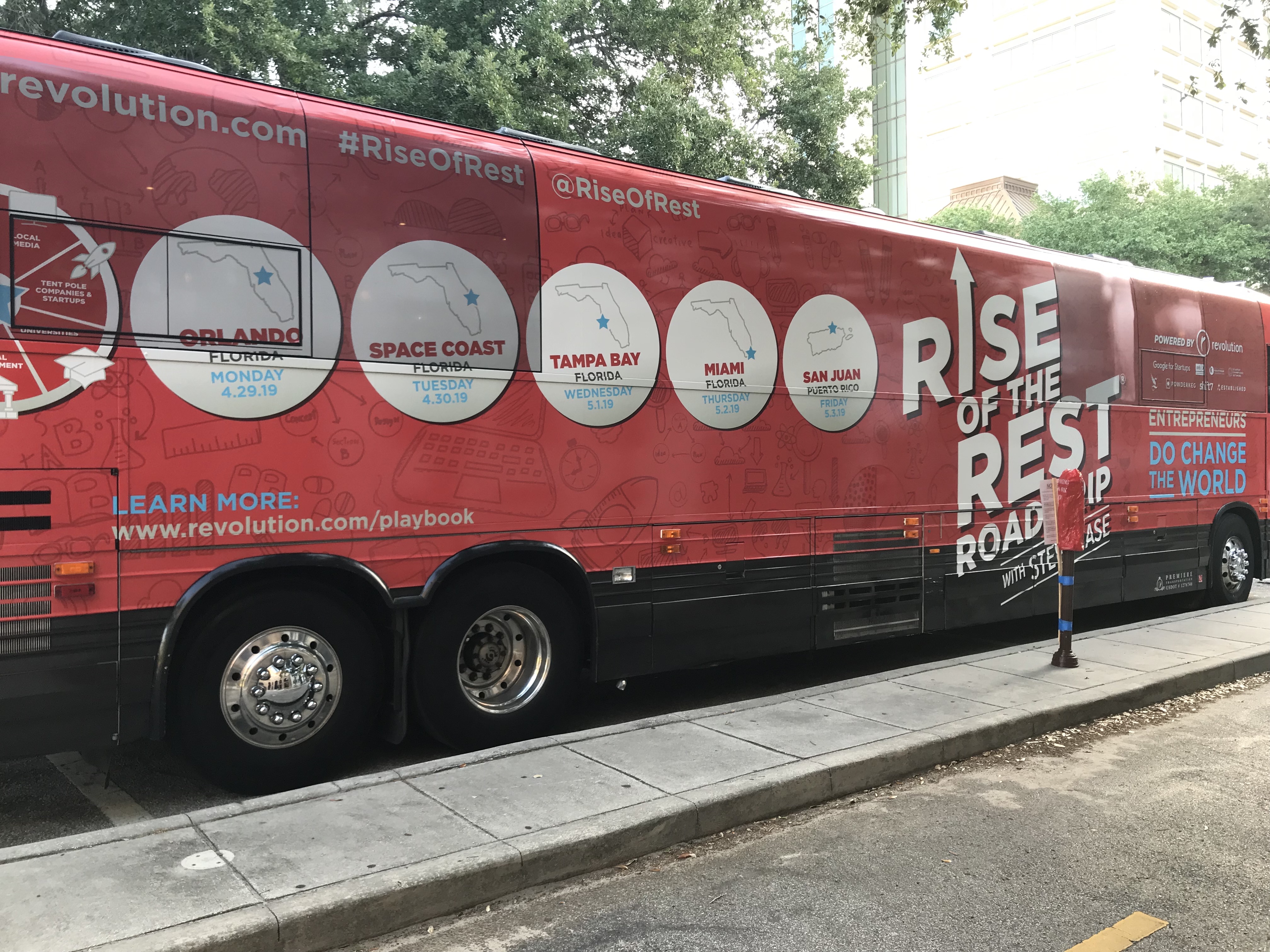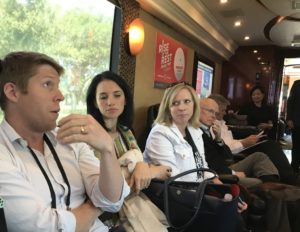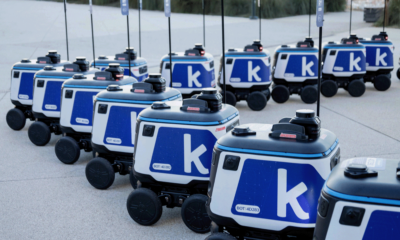Know
Exclusive: On the Rise of the Rest bus with Steve Case

There are three factors that the Tampa-St. Petersburg area needs to work on to grow its startup community, according to Steve Case, chairman and CEO of the Washington, D.C.-based venture capital firm Revolution.
One is big business involvement in young companies. Another is winning the battle for talent. The third is venture funding.
Case outlined the opportunities and challenges in an exclusive interview with the St. Pete Catalyst, which was the only local news outlet to have a reporter travel all day Wednesday with Case and his team as they brought their Rise of the Rest tour to the area.
Rise of the Rest Tour is an initiative to focus on promising startups outside of the major technology hubs. Tampa Bay area was one of five stops the group, which travels by bus, is making this week in Florida and Puerto Rico.
Being able to sit in on the conversations that took place on the tour bus provided some invaluable insights into what venture capitalists like Revolution look for when they invest. More on that below.

Steve Case, speaking Wednesday at Station House in St. Petersburg
Overall, Case sees a lot of positive movement in the area’s tech and startup ecosystem.
Case: The number one thing that stands out is the recognition of the importance of startups and that sounds like it wasn’t really true 10 years ago, but it’s true at least for a lot of people now.
Second would be the collaboration. I heard that a number of times during the day, where the startup community is more collaborative. I also heard that getting some of the big businesses involved would be helpful. Linking Tampa and St. Pete more as a region would be helpful. But there is a lot of collaboration, more than we’ve seen in other cities.
There’s a lot of energy. There’s a lot of sense of possibility. I’m intrigued that some of the people we’ve met who grew up here and stayed here, maybe 10 or 20 years ago they would have left, because the opportunities somewhere else would be better. And the number of people who’ve moved here, including several from Silicon Valley, feeling like this is a better place to start a company than in Silicon Valley.
So overall I think it bodes well for the future of the Tampa-St. Pete area, and more broadly Florida. But there’s still a lot of work to be done to make sure more companies actually do get started, to make sure more venture capital does start flowing, to make sure Tampa-St. Pete wins its battle for talent and fewer people leave, more people return, and make it even more collaborative, get some of the big businesses more engaged. But I’ve been really impressed with what I’ve seen so far.
St. Pete Catalyst: You talked about making sure more venture capital gets involved. Are you seeing anything that’s holding that back right now?
Case: What’s holding it back is most of the venture capital funds, the dollars, are in places like New York, California and Massachusetts, and most of them have a tendency to invest in their backyard, as opposed to get on planes. Over time, they learn about different cities – Austin or Seattle or Chicago, cities like that are starting to get more venture capital because the venture capitalists have seen more successes and start making more investments. So it takes some time to get the national venture capital.
It also takes some time to get regional venture capital firms built up, so they have some scale, and it takes some time to get the angel networks working together. I saw some examples of that and talked to a couple of guys working on a Florida crowd-funding platform that I thought was encouraging.
It takes time. It’s not going to happen overnight, but some of it – and that’s why we’re here – is shining a spotlight on some of the interesting companies, on some of the promising entrepreneurs, with the hope that it will motivate more people within the Tampa-St. Pete area to invest in those entrepreneurs and also over time will attract the attention of investors in other places.
St. Pete Catalyst: What would you like to see happening in Florida in three, five, 10 years from now?
Case: Florida is the third largest state, but it’s not in the top three in terms of venture capital. So how do you get more startups starting and more startups scaling to speed-up level?
There’s a little more momentum in Miami. We’ve seen some interesting things, a $3 billion exit of Chewy, a $2 billion financing of Magic Leap. Miami has a little bit of an edge. There’s a little more work to do in Tampa-St. Pete, Orlando and the Space Coast.
But talent is here and understanding of the core technology around financial technology or around special operations in the military or around entertainment, with things like Disney, or certainly around space tech, with what’s happening in the Space Coast.
Florida has been known for great innovations. Fifty years ago, Apollo 11 landed and the Kennedy Space Center was at the epicenter of that. Fifty years ago, Walt Disney imagined taking 40 miles in Orlando and turning it into Walt Disney World. There’s been a history of innovation. We just need to recognize the innovation of the future is not going to come from the big companies, generally. It’s going to come from the small companies and so how do you redirect your focus to backing more entrepreneurs building interesting companies in places all across Florida.
That data last year from the NVCA [National Venture Capital Association] was 1.3 percent of venture capital dollars went to Florida. Over 50 percent went just to California, to give you a sense of the challenge, but also the opportunity.
I expect over the next 10 years that number to grow. More dollars would be invested in Florida startups. I would expect more jobs to be created because startups create most of the jobs. I would expect the brain drain to slow. More people growing up here and going to school here will stay. I would expect the boomerang of people returning to accelerate.
I think that bodes well for Florida and how it can emerge as a large and highly respected state where a lot of people are moving every single day, but it’s not really known – even within Florida, let alone around the country – as a startup state. How does it go from being a tourism or a sunshine state to being a startup state? I think the opportunity is there. The question is – will the community continue to build on the good work that’s been done in the last 10 years and really grab that ring, grab that opportunity?
The St. Pete Catalyst interviewed Case on the tour bus, where a lot of the conversation centered on issues around diversity among local entrepreneurs.

Linda Olson (center), president and CEO of Tampa Bay Wave, on the Rise of the Rest bus.
Efforts are underway to grow the black startup community, such as James Faison’s Mainframe project, Lakshmi Shenoy, CEO of Embarc Collective, told the group but she added there’s a long way to go. There’s a strong group of Indian entrepreneurs, fostered by Dr. Kiran Patel, himself a healthcare entrepreneur, said Brian Kornfeld, co-founder of Synapse. And Tampa Bay Wave is about to start its second “Tech Diversity Accelerator,” focused on companies founded and led by diverse entrepreneurs, said Linda Olson, President and CEO. The organization has received more than 400 applications for a dozen spots.
The Rise of the Rest staff offered ideas from other communities to bolster local diversity initiatives and bring more people to the table. It requires intentionality, staff members said.
For instance, during a hard-hat tour of Embarc, Shenoy had stepped back, out of the range of cameras, during remarks by Case and Tampa Bay Lightning owner Jeff Vinik, a key financial backer of Embarc. Case called her forward into the spotlight. That’s the type of action that can foster more awareness and inclusion, said Megan Smith, the third Chief Technology Officer of the United States and assistant to the president, serving under President Barack Obama. Smith, an investor in the Rise of the Rest fund, rode on the bus.

Lakshmi Shenoy of Embarc Collective, Dean Collura of TitleTap, Rachel Carpenter of Intrino and Marc Blumenthal of Florida Funders were among those on the Rise of the Rest’s Cross-Bay Ferry trip.
The Rise of the Rest staff also facilitated conversations among small groups of local entrepreneurs as the group traveled from St. Pete to Tampa on the Cross-Bay Ferry, with a focus on why they built their companies in the area and the resources and challenges they have found here.
The ferry trip, a 45-minute ride across Tampa Bay, highlighted one of the potential challenges the area faces — lack of mass transit, which allows people to get work done during travel time, and dependence on cars and aging infrastructure, such as the Howard Frankland Bridge.
“How can we turn the bridge from a disadvantage to an advantage,” asked Rachel Carpenter, CEO of St. Pete financial technology firm Intrinio.
In the small group that the St. Pete Catalyst sat in on, there were energetic conversations about funding — bootstrapping versus taking outside investment — and how to integrate more technology into real estate, the area’s dominating economic driver. Media, such as the St. Pete Catalyst with its focus on startups and technology, can help change the narrative about the local economy by telling stories about young companies, said David Hall, a partner in the Rise of the Rest Seed Fund.







